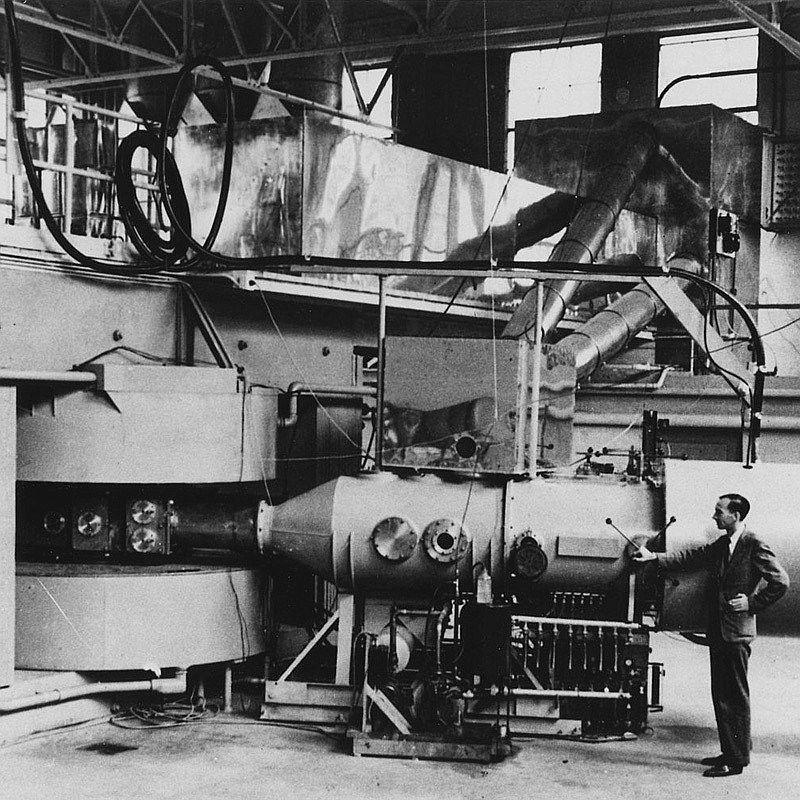Berkelij
97
Bk
Skupina
n/p
Perioda
7
Blok
f
Protoni
Elektroni
Nevtroni
97
97
150
Splošne lastnosti
Vrstno število
97
Atomska teža
[247]
Masno število
247
Kategorija
Aktinoidi
Barva
n/p
Radioaktivno
Da
Named after Berkeley, California, the city of its discovery
Kristalna struktura
Heksagonalna
Zgodovina
Berkelium was discovered by Glenn T. Seaborg, Albert Ghiorso and Stanley G. Thompson in 1949 at the University of California, Berkeley.
It was produced by the bombardment of americium with alpha particles.
Berkelium was isolated in greater quantities for the first time by Burris Cunningham and Stanley Thompson in 1958.
It was produced by the bombardment of americium with alpha particles.
Berkelium was isolated in greater quantities for the first time by Burris Cunningham and Stanley Thompson in 1958.
Elektroni po lupinah
2, 8, 18, 32, 27, 8, 2
Razporeditev elektronov
[Rn] 5f9 7s2
Just over one gram of berkelium has been produced in the United States since 1967
Fizikalne lastnosti
Faza snovi
Trdnina
Gostota
14,78 g/cm3
Tališče
1259,15 K | 986 °C | 1806,8 °F
Vrelišče
3173,15 K | 2900 °C | 5252 °F
Talilna toplota
n/p kJ/mol
Izparilna toplota
n/p kJ/mol
Toplotna kapaciteta
- J/g·K
Zastopanost v Zemljini skorji
n/p
Zastopanost v vesolju
n/p

Zasluge za slike: Wikimedia Commons (Department of Energy - Office of Public Affairs)
The 60-inch cyclotron at the Lawrence Radiation Laboratory, University of California, Berkeley
CAS številka
7440-40-6
PubChem CID številka
23971
Atomske lastnosti
Atomski polmer
170 pm
Kovalentni polmer
-
Elektronegativnost
1,3 (Paulingova lestvica)
Ionizacijski potencial
6,1979 eV
Atomski volumen
16,7 cm3/mol
Toplotna prevodnost
0,1 W/cm·K
Oksidacijska stanja
3, 4
Uporabe
Berkelium is mainly used for scientific research purposes.
Berkelium-249 is a common target nuclide to prepare still heavier transuranic elements and transactinides, such as lawrencium, rutherfordium and bohrium.
It is also useful as a source of the isotope californium-249.
Berkelium-249 is a common target nuclide to prepare still heavier transuranic elements and transactinides, such as lawrencium, rutherfordium and bohrium.
It is also useful as a source of the isotope californium-249.
Berkelium is harmful due to its radioactivity
Izotopi
Stabilni izotopi
-Nestabilni izotopi
233Bk, 235Bk, 236Bk, 237Bk, 238Bk, 239Bk, 240Bk, 241Bk, 242Bk, 243Bk, 244Bk, 245Bk, 246Bk, 247Bk, 248Bk, 249Bk, 250Bk, 251Bk, 252Bk, 253Bk, 254Bk